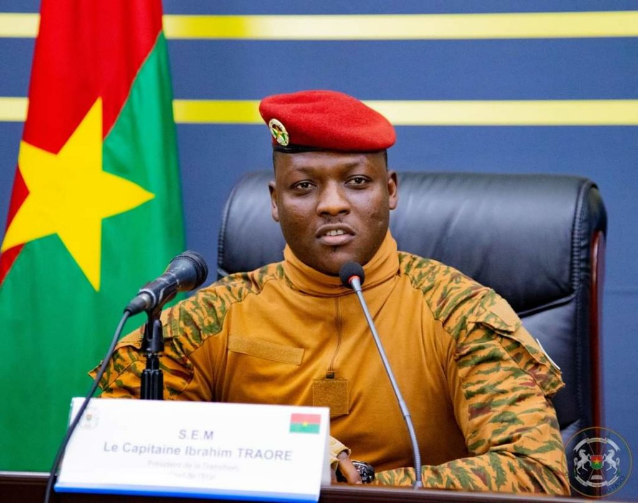Burkina Faso raises US$47 million in the Abidjan regional stock exchange
Abdel Aziz Ouedraougo
Ouagadougou, Burkina FasoMarch 25, 2025

President Ibrahima Traore, Burkina Faso
B urkina Fasoraised US$47 million (30 billion FCFA) in its first issue of the year on the Monetary Union of West African States (UEMOA) securities market. The UEMOA is the regional organization that oversees the functioning of the CFA franc in eight states.
The initial target was 30 billion FCFA, but the issue raised 43.36 billion FCFA, representing a coverage rate of 144.55 percent. Burkina Faso issued three instruments: a short-term note (maturity of 364 days) and three medium and long-term bonds (with maturities of three, five and seven years). Burkina Faso has 12 government bonds listed in the Abidjan regional stock exchange, out of 96 government sovereign and money market instruments 1.
Investors from six UEMOA member states subscribe to the offering. These include domestic investors in Burkina Faso US$30.5 million (18.48 billion FCFA), Benin US$17.1 million (10.38 billion FCFA) and Côte d’Ivoire US$7.9 million (4.74 billion FCFA). Other investors were from Senegal US$4.3 million (2.63 billion FCFA), Togo US$4.1 million (2.5 billion FCFA) and Mali US$61.2 thousand (0.037 billion FCFA). The bond investors are commercial and retail banks, insurance companies, pension funds, and private independent fund managers.
Tackling agricultural decline
Ghana wants to reverse the decline of its agricultural sector. In 2017 when the Cocoa Board (COCOBOD) launched the ‟ Hand Pollination”. The Cocoa institution called the scheme ‟a nationwide implementation of the novelty to increase yields and provide sustainable incomes for farmers”. The goal, it said, was to increase productivity to over 1000 kg per hectare. With this approach, the COCOBOD wanted cocoa farmers to gain skills in hand pollination. The COCOBOD exited the program after training pollinators who continue to help farmers to undertake the activity for a fee.
Artificial Hand Pollination was a component of a large program to boost cocoa productivity. The COCOBOD called it the Productivity Enhancement Programs (PEPs). Its goal was to reverse declining cocoa yields. Hand pollination was part of the so-called ‟4Ps”: Pruning, Pollination, Poultry Manure, and Protection. But, hand pollination has produced mixed results. After recording its highest ever cocoa production of 1,047, 000 metric tons during the harvest season 2020/2021, production has declined and continues to stagnate 800,000 tons per year. Other factors, such as crop diseases, smuggling and the devastating activities of illegal gold miners have also contributed to the fall.
The economy of Burkina Faso
Burkina Faso is a landlocked economy which depends on minerals and agriculture and on export of gold, cotton, and livestock. The country also imports food, electricity, manufactured products, oil, and gas. The International Monetary Fund (IMF) estimates that external factors, especially commodity prices, have a negative influence on Burkina’s balance of payment. Over the past decade, climate change, an undiversified economy, and elevated food and energy prices have further exacerbated fiscal and trade deficits. Besides, an escalation of the security situation in the Sahel has exacerbated political instability in the country. Compared to its neighbors, Burkina Faso is a relatively small economy with a nominal gross domestic product of US$20.32 billion in 2023.
GDP growth has averaged 4.9 percent over the past decades, ranking the country amongst the highest performer in Sub Saharan Africa, since the 1980s. Inflation has also been relatively low staying below 10 percent since 2022. At the end of 2024 inflation hovered around 3 percent (compared to Ghana its southern neighbor, 23 percent). However, despite these stable economic indicators, social indicators are weak. Poverty is rampant and the economy is dominated by informality amidst persistent security concerns. These risks, however, do not seem to deter the appetite of regional institutional investors for Burkina Faso’s bonds.
Debt sustainability
The International Monetary Fund (IMF) estimates that Burkina Faso is at Burkina Faso is at moderate risk of external debt distress and overall public debt distress. The IMF also estimates that the country remains sustainable over the medium term. At the end of 2024, the total nominal public debt of Burkina Faso was US$11.6 billion or 56 percent of the national GDP.
External debt represented 45.9 percent and domestic debt 54.1 percent of the GDP respectively.
Burkina Faso relies on the BRVM for fund raising. In fact, 84.8 percent of domestic its debt trade in the regional market. In September 2024, Burkina Faso listed two sovereign bonds on the BRVM, raising $217 million. The bonds were the five-year TPBF 6.30 percent 2024-2029 and the seven year TPBF 6.55 percent 2024-2031. Burkina Faso is the second largest issuer of African sovereign bonds on the BRVM.
Related Articles
BIBLIOGRAPHY
1❩ https://www.finances.gov.bf/fileadmin/user_upload/storage/Bulletin_statisque_de_la_dette_N__2-_2024_.pdf
